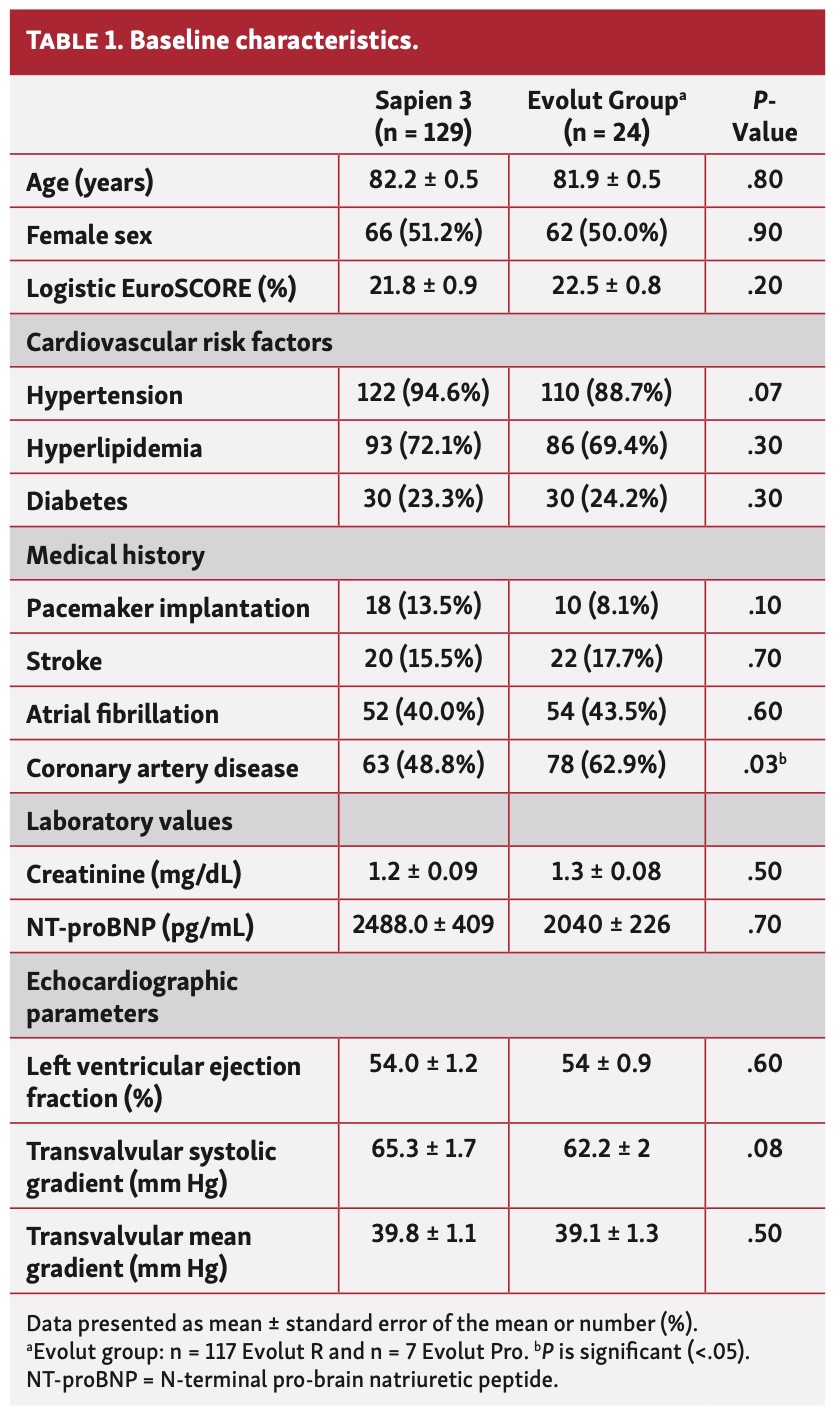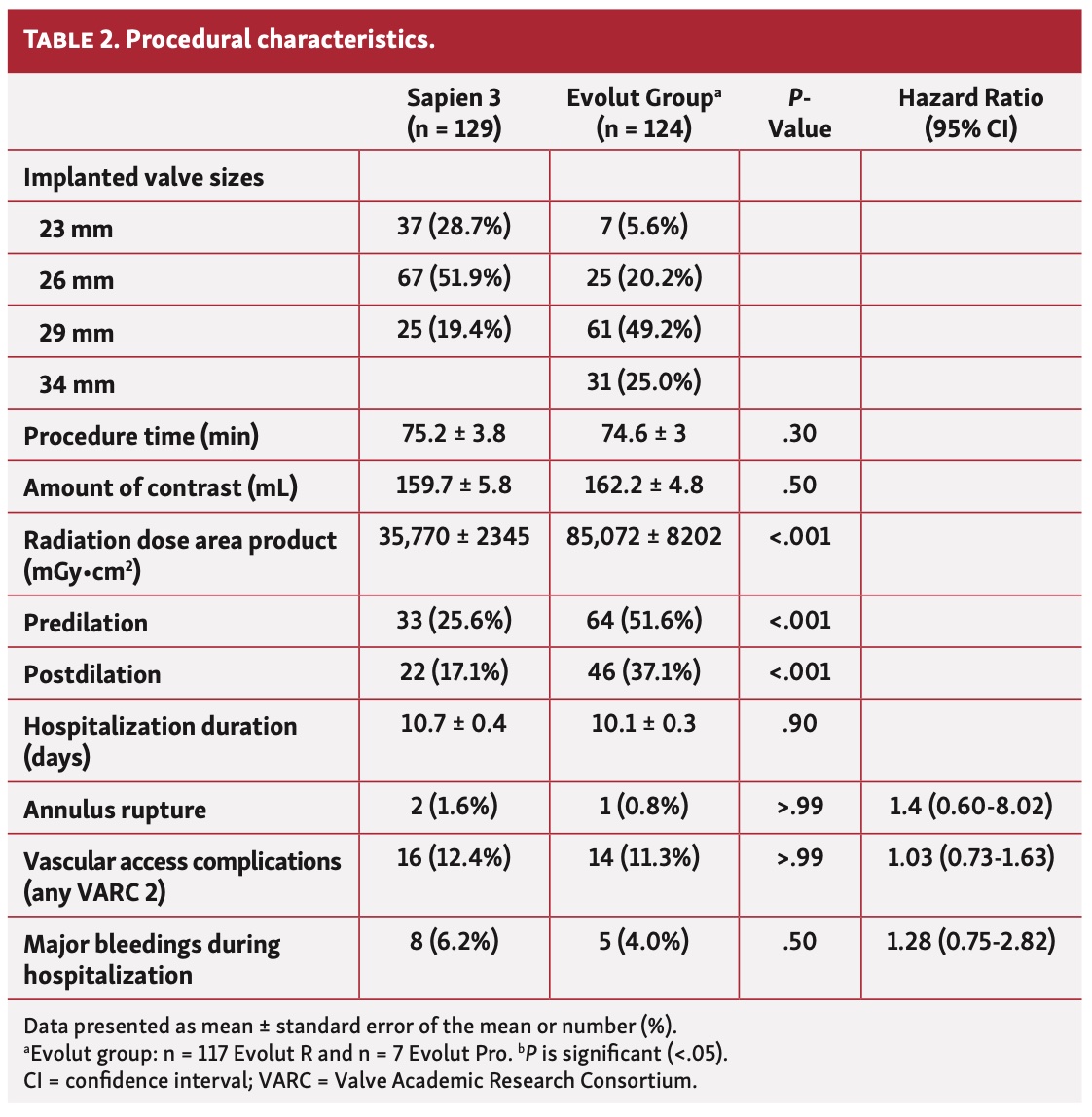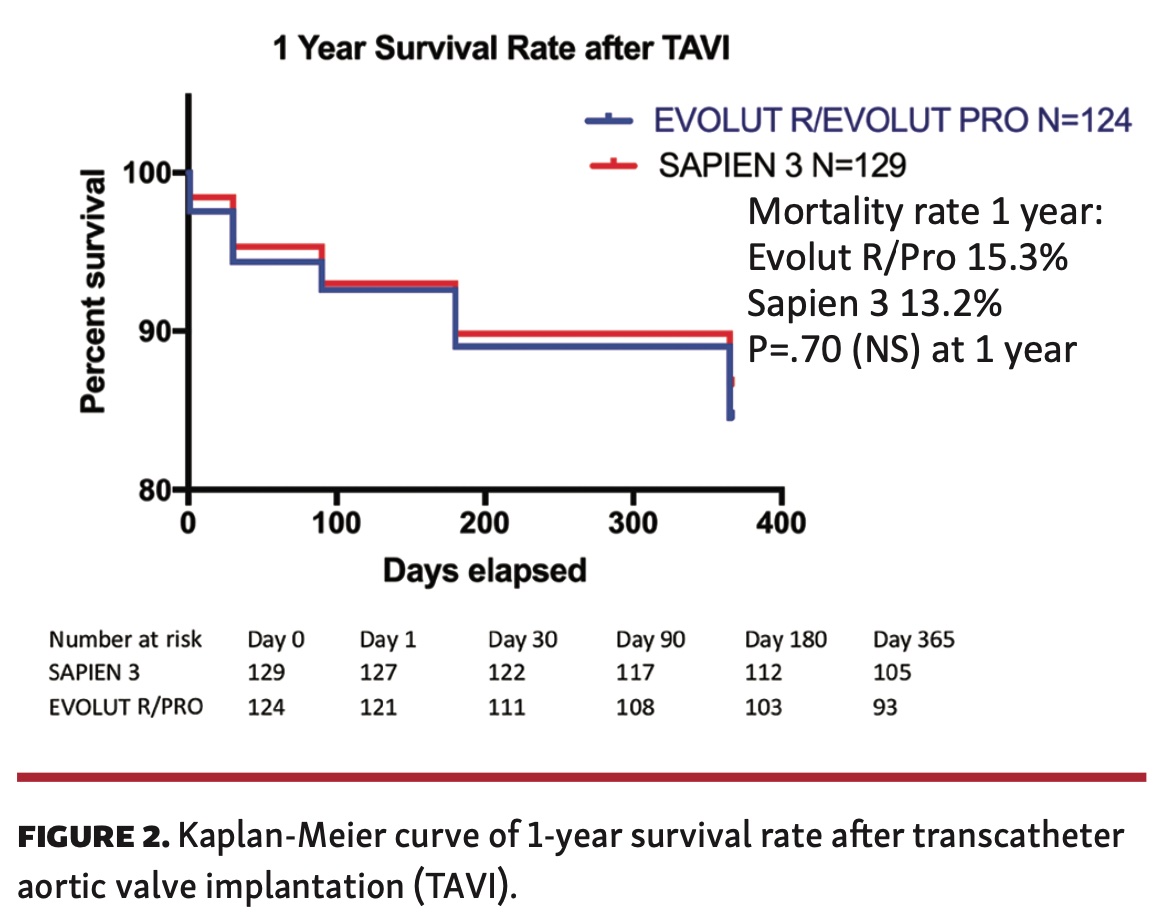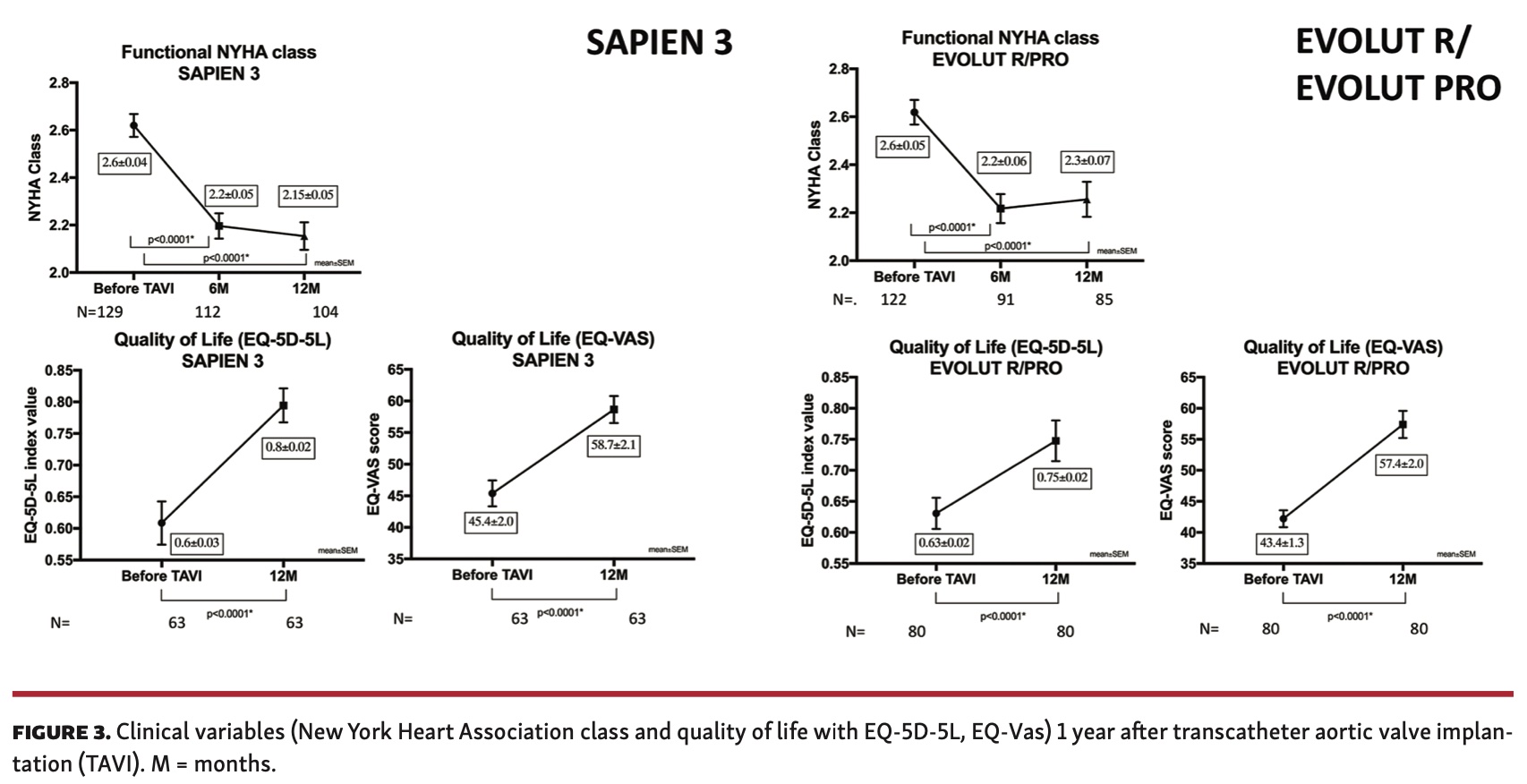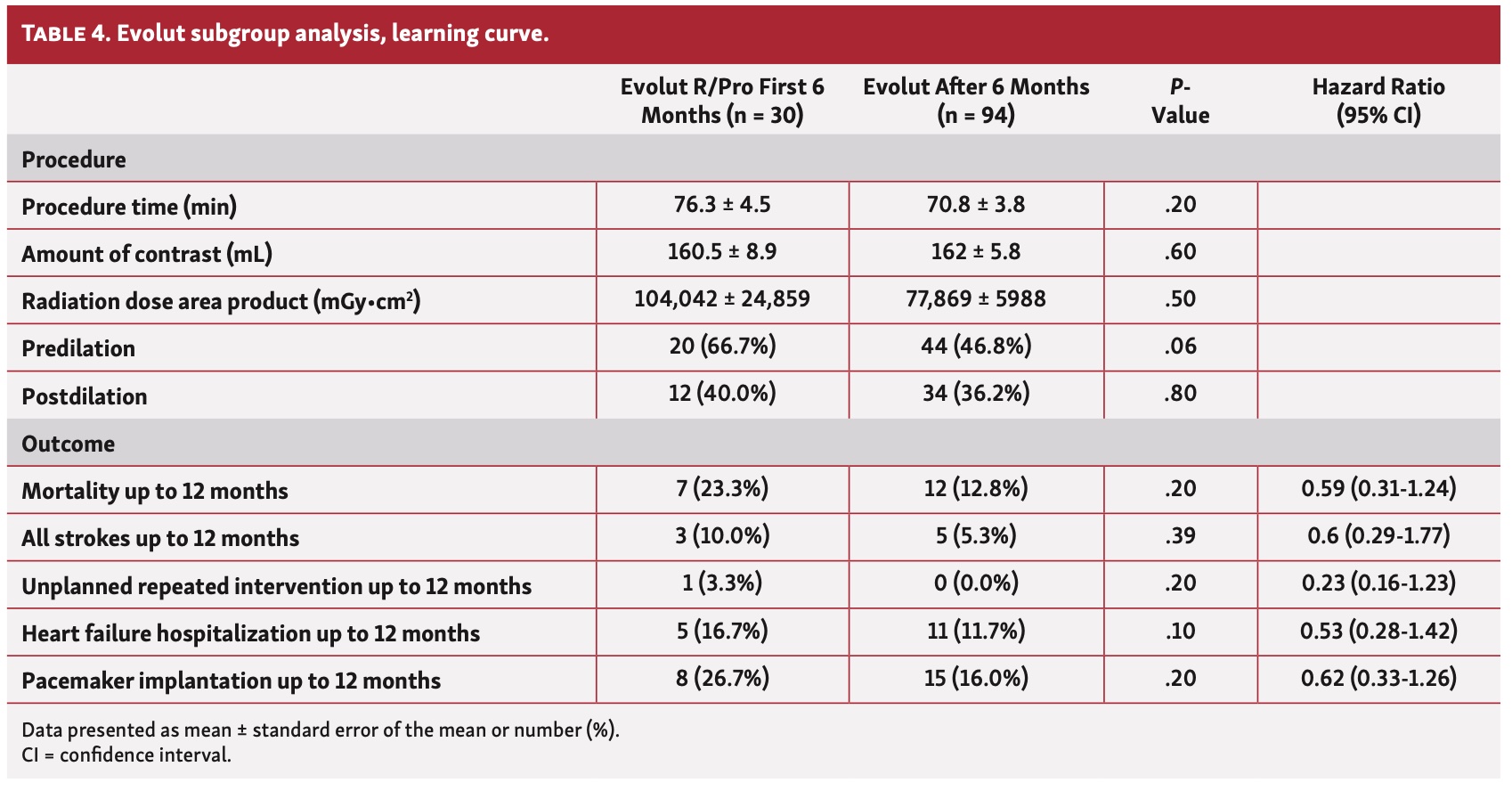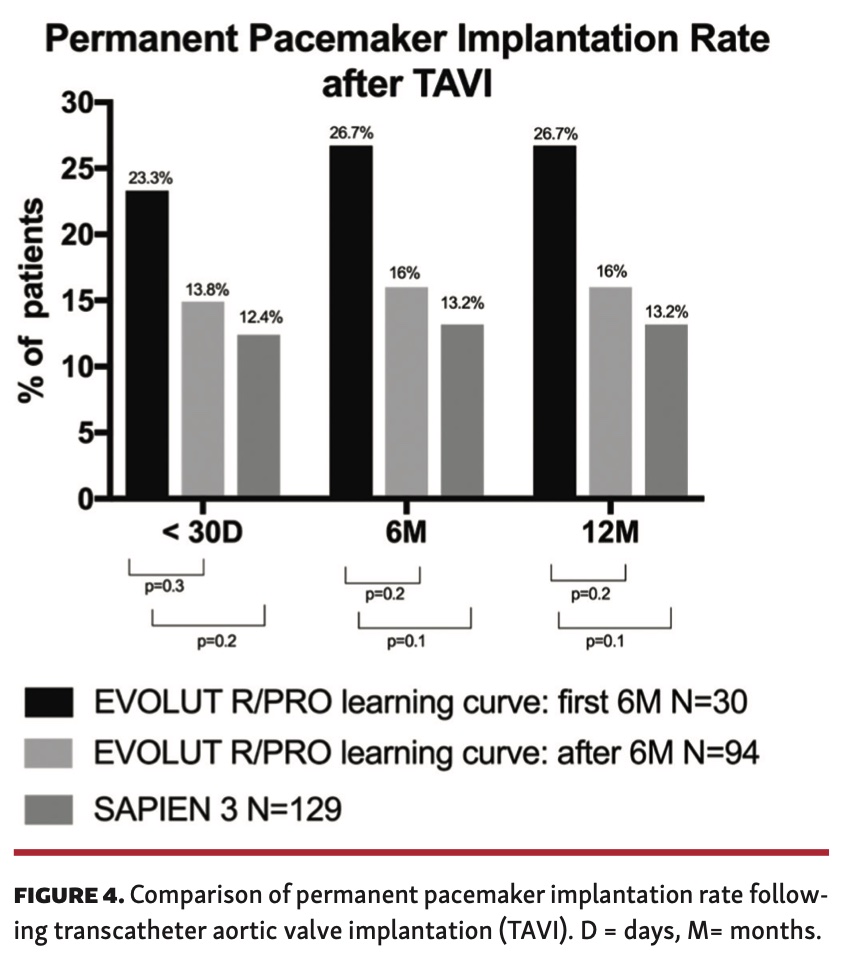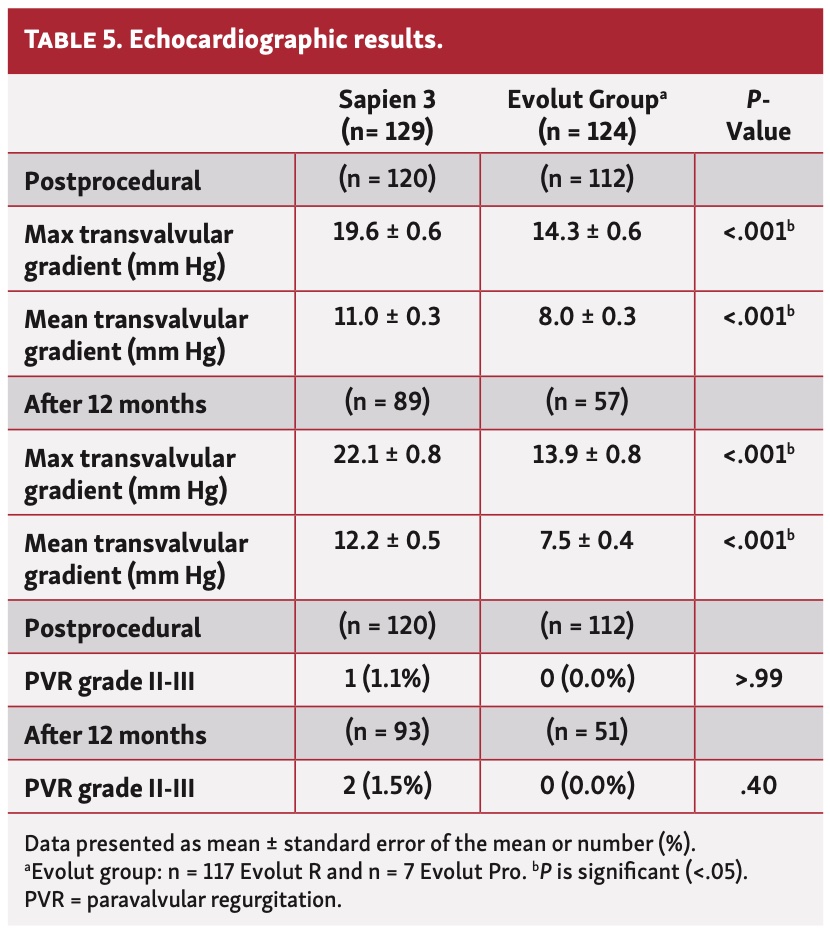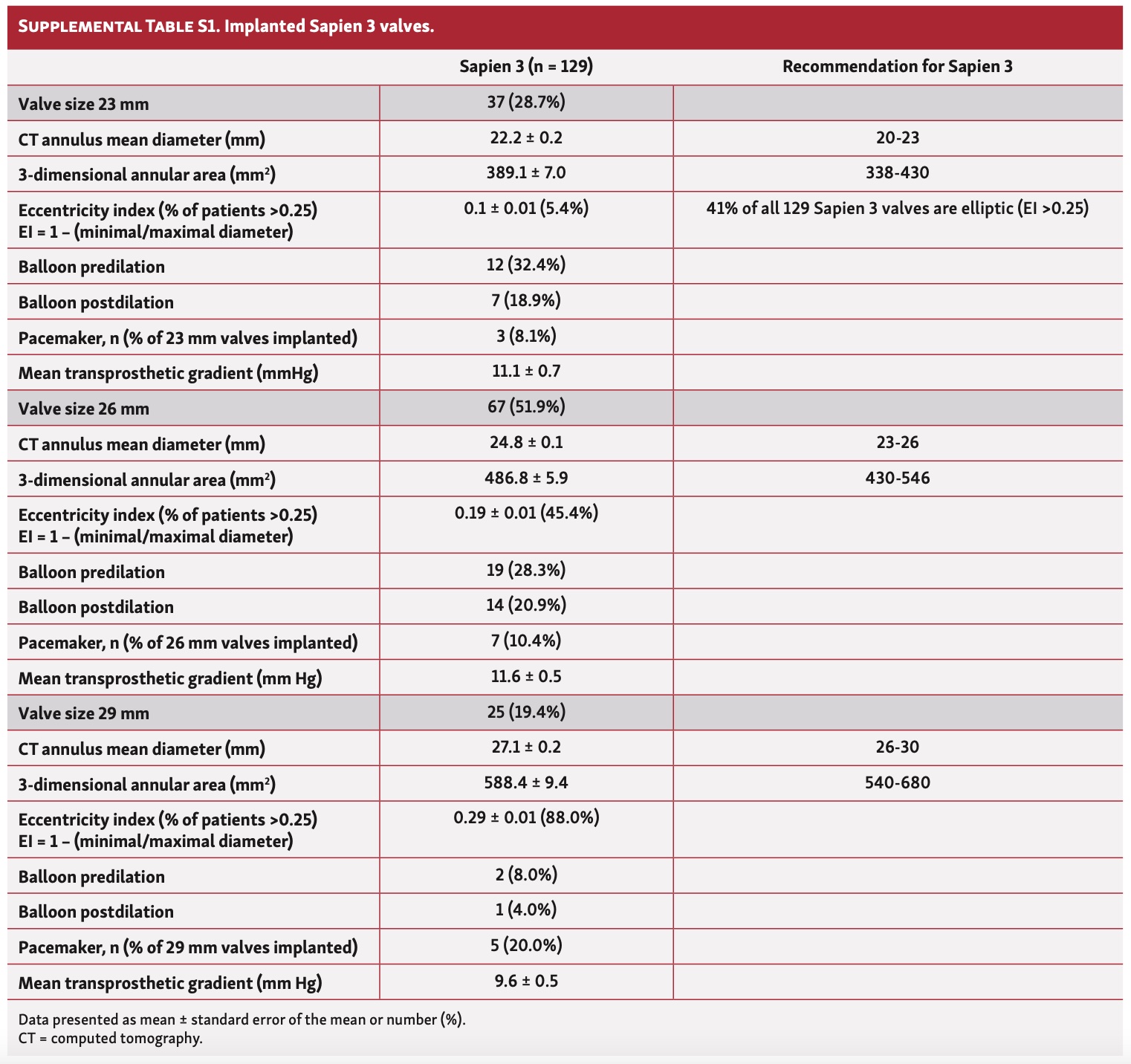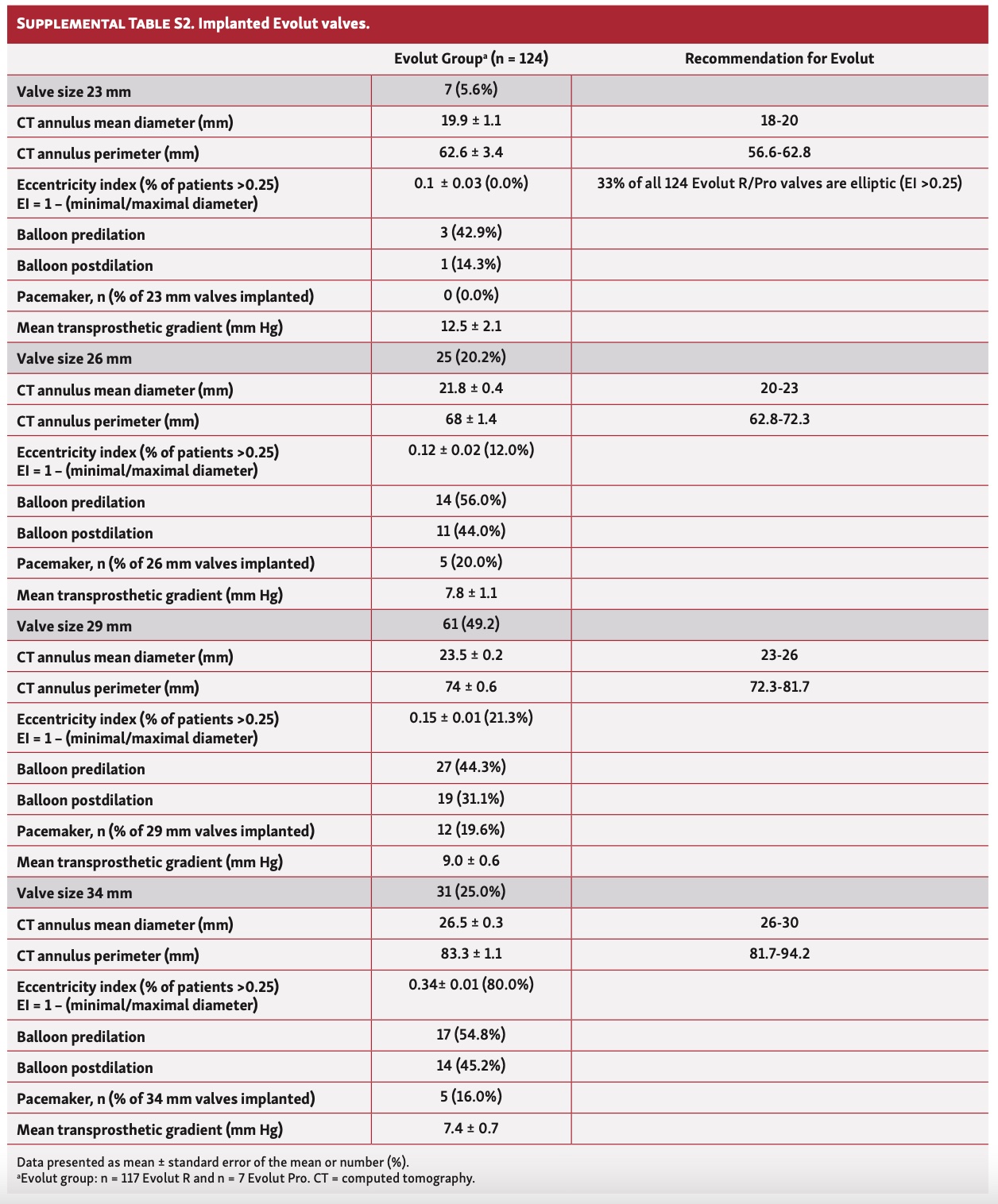The ALSTER-TAVI All-Comers Registry: Procedural and 1-Year Clinical Outcomes of Balloon-Expandable vs Self-Expanding Contemporary TAVI Valves
Abstract
Objectives. Both balloon-expandable and self-expanding transcatheter aortic valves are used for transcatheter aortic valve implantation (TAVI). We compared procedural and clinical outcome variables of Sapien 3 and Evolut R/Pro in an all-comers collective. Methods. In this single-center registry, patients were consecutively treated with the Sapien 3 from November 2014 to March 2017 (n = 129) and from April 2017 to December 2018 mainly (>95%) with the Evolut R/Pro (n = 124), due to a switch in the main TAVI supplier driven by hospital management. Data were retrospectively analyzed before and after the switch. Results. One-year follow-up data were available for 122 (94%) of the Sapien and 112 (90%) of the Evolut patients. Baseline characteristics were comparable (EuroSCORE: Sapien 21.8 ± 0.9% vs Evolut 22.5 ± 0.8%; P=.20). Evolut implantation was associated with a higher radiation dose (Sapien 35770 ± 2345 mGy•cm2 vs Evolut 85072 ± 8202 mGy•cm2; P<.001), more postimplantation balloon dilations (Sapien 17.1% vs Evolut 37.1%; P<.001), but similar procedure time (Sapien 75.2 ± 3.8 min vs Evolut 74.6 ± 3 min; P=.30). In-hospital mortality (Sapien 3.1% vs Evolut 4.0%; P=.70), all-cause mortality (Sapien 13.2% vs Evolut 15.3%; P=.70), all-stroke rate (Sapien 1.5% vs Evolut 6.5%; P=.05), and pacemaker implantation rate (Sapien 13.2% vs Evolut 18.5%; P=.30) were similar at 1 year. Permanent pacemaker rate was numerically higher in the first 6 months with Evolut (<6 months 26.7% vs >6 months 16%; P=.62); furthermore, radiation dose and balloon dilations also suggest a learning curve with Evolut. Conclusions. Switching from Sapien 3 to Evolut R/Pro was not associated with a difference regarding periprocedural or 1-year clinical outcomes.
J INVASIVE CARDIOL 2021;33(5):E356-E364. doi:10.25270/jic/20.00472
Key words: Evolut valve, learning curve, radiation, registry, Sapien 3 valve, SAVR, TAVI, TAVR
Transcatheter aortic valve implantation (TAVI) has emerged as the default treatment for aortic stenosis in patients at elevated risk for open heart surgery. This is based on several randomized clinical trials comparing TAVI with surgical aortic valve replacement (SAVR).1-4 Moreover, recent trials show non-inferiority (CoreValve/Evolut) or even a reduced rate (PARTNER 3) for the composite of death, stroke, or rehospitalization with TAVI in patients at low surgical risk compared with SAVR.5,6
No large head-to-head comparisons of the two predominantly used valves (Sapien 3 [Edwards Lifesciences] and Evolut R/Pro [Medtronic]) have been performed so far to compare long-term clinical outcomes. However, few randomized trials (CHOICE and SCOPE I)7,8 and analyses from registry data9 showed differences in hemodynamic function, paravalvular sealing, and periprocedural complications, most likely due to the different inherent technical valve properties. Two propensity-matched analyses from large French registries recently showed lower rates of death, paravalvular regurgitation (PVR), permanent pacemaker (PPM) implantation, and rehospitalization with balloon-expandable vs self-expanding valves.10,11
While real-world data on Sapien 3 and Evolut R/Pro are readily available, no data are available on the impact of switching the default valve from balloon-expandable to self-expandable in a given medium-sized TAVI program. The ALSTER TAVI all-comers registry summarizes the clinical results after a decision was made in Spring 2017 to switch from a balloon-expandable valve (Sapien 3) to >95% self-expanding valves (Evolut R/Pro). We hypothesized a learning curve and compared early vs late results within the Evolut group.
Methods
The ALSTER TAVI study is an all-comers, single-center, retrospective registry that included consecutive patients who underwent TAVI between November 2014 and December 2018. To improve the cost effectiveness of TAVI, the hospital management urged a switch from the balloon-expandable Sapien 3 bioprosthesis to the self-expanding Evolut R and Evolut Pro valves. Therefore, in this medium-sized TAVI program, all patients were treated with the balloon-expandable Sapien 3 from November 2014 to March 2017, while >95% were treated with the self-expanding Evolut R or Evolut Pro valve after the switch in April 2017. Only a few implantations (4%) after the program switch were performed with valve types other than Evolut R/Pro (ie, the Sapien 3 or Acurate neo valve [Boston Scientific]) because of logistic reasons and not due to specific patient selection criteria. All implantations were performed by experienced operators. The primary aim of this registry was to compare procedural variables and clinical outcomes between patients treated with Sapien 3 and Evolut R/Pro bioprostheses. Furthermore, we aimed to compare early (< 6 months after the switch) and late (>6 months after the switch) procedural and clinical results with the Evolut R/Pro valve to identify the impact of a learning curve.
For the purposes of this analysis, all patients undergoing TAVI for severe aortic stenosis with the Sapien 3 and the Evolut R/Pro using femoral access were included. We excluded patients who underwent TAVI with other valve types, transapically implanted aortic valves, bicuspid aortic valves, and valve-in-surgical-bioprosthesis implantations. All patients were considered high risk for valve surgery by our institutional heart team. Patients underwent coronary angiography and computed tomography (CT) of the aortic annulus before implantation; sizing of the aortic annulus and decision on valve size was based on sizing recommendations and instructions for use by the manufacturers based on the native valve annulus perimeter (Evolut R/Pro) or annulus area (Sapien 3) as measured by CT. Clinical follow-up was performed in the outpatient clinic. Data were retrospectively collected from the in-hospital and outpatient electronic databases.
Echocardiographic imaging evaluation. Echocardiographic results were assessed before and after TAVI implantation routinely in hospital and in the outpatient clinic, and were documented in the databases. To evaluate the interobserver variability of these measurements during follow-up after TAVI, we also analyzed images of 50 consecutive TAVI patients (>90% Evolut) with focus on the left ventricular ejection fraction (LVEF), the left ventricular hypertrophy, the grade of PVR, and the transvalvular TAVI Doppler speed (vmax in cm/sec). To evaluate the variability and reproducibility of the acquired echocardiographic values, one experienced echocardiographer performed retrospectively separate measurements, blinded to the initial results on the electronically stored images in the outpatient database.
Statistical analysis. Continuous parameters are reported as mean ± standard error of the mean (SEM). Significance between the groups was assessed by analysis of the Student’s t-test or Mann-Whitney test, where appropriate. Categorical variables are reported as number of patients (% of patients) and were compared using the Pearson χ2 test or the Fisher’s exact test, as appropriate. A P-value <.05 (two-sided) was considered to be statistically significant. Significance within one group was assessed by the Kolmogorov-Smirnov test, followed by the one-sample t-test or the Wilcoxon signed rank-test with “no change” (Δ=0) as the hypothetical (H0) value. Events are reported as counts of first occurrence. The mortality rate is calculated via the Kaplan-Meier method to account for censoring. To assess the interobserver variability of the echocardiographic results, we used the interclass correlation coefficient (non-parametric Spearman correlation r). Statistical analysis was performed using GraphPad Prism, version 8 (GraphPad Software).
Results
Patient population. From November 2014 to March 2017, a total of 129 consecutive patients were treated with the Sapien 3 valve; from April 2017 to December 2018, a total of 124 patients were treated with Evolut valves (n = 117 Evolut R and n = 7 Evolut Pro) and included in this analysis. One-year follow-up data were available for 122 Sapien 3 patients (94%; n = 17 deceased and n = 7 lost to follow-up) and 112 Evolut R/Pro patients (90%; n = 19 deceased and n = 12 lost to follow-up). The patient disposition flow chart is presented in Figure 1. Baseline characteristics are summarized in Table 1. The two groups showed similar characteristics. Specifically, no significant differences were found for the mean logistic EuroSCORE (21.08 ± 0.9% in the Sapien 3 group vs 22.5 ± 0.8% in the Evolut R/Pro group; P=.20) and age (82.2 ± 0.5 years in the Sapien 3 group vs 81.9 ± 0.5 years in the Evolut R/Pro group; P=.80). Valves implanted are listed in Table 2. Seven patients in the Evolut group were treated with a 29 mm Evolut Pro valve and the remaining patients underwent implantation with Evolut R valves.
Procedural parameters and in-hospital outcome. Implantation of Evolut valves was associated with a higher radiation dose-area product (35,770 ± 2345 mGy•cm2 in the Sapien 3 group vs 85,072 ± 8202 mGy•cm2 in the Evolut R/Pro group; P<.001), but similar procedure time (75.2 ± 3.8 min in the Sapien 3 group vs 74.6 ± 3 min in the Evolut R/Pro group; P=.30) and no difference in the amount of contrast used (159.7 ± 5.8 mL in the Sapien 3 group vs 162.2 ± 4.8 mL in the Evolut R/Pro group; P=.50). Operators decided to perform predilations in 25.6% of the Sapien 3 group and 51.6% of the Evolut R/Pro group (P<.001). Postimplant balloon dilation was necessary in 17.1% of the Sapien 3 group and in 37.1% of the Evolut R/Pro group (P<.001). There were 2 fatal annulus ruptures in the Sapien 3 group (1.6%) and 1 fatal rupture following postdilation in the Evolut group (0.8%). Furthermore, 1 fatal ventricular perforation and 1 fatal TAVI dislocation occurred during the procedure in the Evolut group. Vascular access complications (including smaller bleedings [Blood Academic Research Consortium 1-2], dissections, perforation, and peripheral embolization) were similar in both cohorts (12.4% in the Sapien 3 group vs 11.3% in the Evolut R/Pro group; P>.99). Procedural characteristics are summarized in Table 2 and detailed characteristics of the implanted valves are presented in Supplemental Tables S1 and S2. Mean hospital stay (10.7 ± 0.4 days in the Sapien 3 group vs 10.1 ± 0.3 days in the Evolut R/Pro group; P=.90), in-hospital mortality (3.1% in the Sapien 3 group vs 4.0% in the Evolut R/Pro group; P=.70) and in-hospital pacemaker rates were comparable (12.4% in the Sapien 3 group vs 16.1% in the Evolut R/Pro group; P=.40).
Clinical outcome up to 1 year. Clinical outcomes up to 1 year are detailed in Table 3 and Figure 2. No significant differences were found for all-cause death (13.2% in the Sapien 3 group vs 15.3% in the Evolut R/Pro group; P=.70), all stroke (1.5% in the Sapien 3 group vs 6.5% in the Evolut R/Pro group; P=.05), myocardial infarction (1.6% in the Sapien 3 group vs 0.8% in the Evolut R/Pro group; P>.99), acute renal failure (4.7% in the Sapien 3 group vs 3.2% in the Evolut R/Pro group; P=.70), and hospitalization rate for heart failure (11.6% in the Sapien 3 group vs 12.9% in the Evolut R/Pro group; P=.80).
One patient underwent balloon valvuloplasty 5 months after Sapien 3 valve implantation due to high-grade PVR, without sequelae and 1 Evolut R patient underwent SAVR due to endocarditis of the TAVI bioprosthesis 10 months after implantation.
Three Sapien 3 patients and 1 Evolut R patient showed signs of leaflet thrombosis during follow-up, with rise of the transvalvular gradients (mean gradient >20 mm Hg) as measured by transthoracic echocardiography during follow-up. Oral anticoagulation with dabigatran was initiated in all of these patients. One patient suffered from a thalamic infarction during this treatment, transvalvular gradient decreased in all patients to ≤20 mm Hg. Rates of PPM implantation were comparable between the groups at 1 year (13.2% in the Sapien 3 group vs 18.5% in the Evolut R/Pro group; P=.30). The majority were implanted during index hospitalization, due to third-degree atrioventricular block. When analyzing the electrocardiogram prior to the procedure, 64.7% of Sapien 3 patients and 69.2% of Evolut patients had a predisposition with first-degree atrioventricular block or bundle-branch block (100% right bundle-branch block in the Sapien 3 group; 83% right bundle-branch block and 17% left bundle-branch block in the Evolut R/Pro group).
Clinical variables (functional New York Heart Association class and quality of life with EQ-5D-5L, EQ-Vas) were assessed retrospectively and suggest clinical improvement after 1 year. Results are depicted in Figure 3.
Evolut subgroup analysis and learning curve. Results of the comparison of early vs late procedures after switching the program are depicted in Table 4 and Figure 4. The radiation dose area product (10,4042 ± 24,859 mGy•cm2 the first 6 months vs 77,869 ± 5988 mGy•cm2 after 6 months; P=.50), balloon predilation and postdilation (predilation, 66.7% the first 6 months vs 46.8% after 6 months; P=.06; postdilation, 40.0% the first 6 months vs 36.2% after 6 months; P=.80), and the permanent pacemaker rate at 1 year (26.7% the first 6 months vs 16% after 6 months; P=.20) were numerically higher early after switching the program, but the difference was not statistically significant. Furthermore, we observed no difference in clinical outcomes at 1 year.
Results of the echocardiographic image evaluation. Patients with Evolut valve implantations showed significantly lower transvalvular gradients post procedure (P<.001) and after 12 months (P<.001). The PVR rate (≥ grade 2) was not significantly different between the Evolut and Sapien groups, with 2 high-grade PVRs in the Sapien 3 group (1 underwent repeated valve intervention and 1 was treated conservatively). Results are detailed in Table 5.
Retrospective echocardiographic image analysis in 50 patients showed left ventricular function in 48/50 (96%; intraclass correlation coefficient [ICC] r, 0.87; 95% confidence interval [CI], 0.78-0.92), left ventricular hypertrophy in 43/50 (86%; ICC r, 0.68; 95% CI, 0.49-0.8), and PVR in 47/50 (94%; ICC r, 0.93; 95% CI, 0.89-0.96) which is in line with the initial measured results. Furthermore, the assessed vmax interobserver difference was low at 21.9 ± 7.1 cm/sec (ICC r, 0.95; 95% CI, 0.9-0.98), indicating a low interobserver variability.
Discussion
The present study is a real-world, retrospective, single-center, all-comers registry comparing procedural and 1-year clinical outcomes of patients treated either with the balloon-expanding Sapien 3 valve or the self-expanding Evolut R or Evolut Pro valve. The main results can be summarized as follows:
- Switching between valve types was not associated with a clinically significant change in outcome measures.
- Pacemaker rate was high in both cohorts at around 15% of patients and often linked to already predisposing factors like right bundle-branch block.
- Pacemaker rate, radiation dose and balloon dilations are numerically higher in the first 6 months of Evolut use compared with later results, suggesting a learning curve.
In-hospital mortality rates were comparable between the Sapien 3 and Evolut R/Pro groups (3.1% all-cause in the Sapien 3 group vs 4% in the Evolut R/Pro group; P=.70) and in line with other national TAVI registries, ranging from 3%-9.7%.12-14 Mortality at 1 year (all-cause mortality, 13.2% in the Sapien 3 group vs 15.3% in the Evolut R/Pro group; P=.70; cardiovascular mortality, 8.5% in the Sapien 3 group vs 7.2% in the Evolut R/Pro group; P=.80) was also similar between the groups, without differences in acute renal failure, myocardial infarction, or hospitalization for heart failure rate. Taking into account the high-risk collective in this registry, the mortality rate was nearly the same as in the REPRISE III trial (13.3%-17.8%, high risk)15 and in the PARTNER 2 trial (14.2%, intermediate risk)3 and lower than in PARTNER 1 (24.2%, high risk)2 and FRANCE 2 (21.2%, high risk).14 We observed numerically more strokes (1.5% in the Sapien 3 group vs 6.5% in the Evolut R/Pro group; P=.05) in the Evolut cohort, but without statistical significance. The CENTER trial also demonstrated a lower incidence of strokes in patients undergoing TAVI with balloon-expandable compared with self-expanding devices, and in PARTNER 3, Sapien 3 implantation resulted in a lower stroke rate than surgery.9 6
The need for PPM implantation was high for both valve types (13.2% in the Sapien 3 group vs 18.5% in the Evolut R/Pro group) at 1 year in this registry. The majority of implantations were performed during hospitalization for the index procedure and were rare during follow-up. PPM implantation is associated with impaired left ventricular ejection fraction recovery post TAVI.16,17 Furthermore, other registries find all-cause mortality to be higher in this collective, but not cardiovascular mortality, heart failure, stroke, or myocardial infarction rate.18 The incidence of PPM implantation after the use of a new-generation TAVI prosthesis ranges in the literature between 2.3% and 36.1%, with rates being lower for the balloon-expandable devices than the self-expanding devices.19 Pre-existent conduction abnormalities (electrical factor), calcification of the left ventricular outflow tract (anatomical factor), balloon valvuloplasty and depth of implantation (procedural factors) are associated with increased risk of PPM implantation.19 Pre-existent conduction abnormalities were present in 64.7% of the Sapien 3 patients and 69.2% of the Evolut patients in our registry, with the majority being right bundle-branch blocks and thereby possibly explaining the high PPM rate. In this registry, balloon dilations were more frequent in the Evolut group compared with the SAPIEN 3 group, and the rate was even higher during the first 6 months. Accordingly, PPM implantation rate was numerically higher in the Evolut group and higher during the first 6 months, but the difference was not clinically significant.
Another important aspect, when assessing comparisons between TAVI devices, is the learning curve for each device. Several prior analyses suggest that a newly introduced valve type is associated with a learning curve, leading to less-favorable results in the early patients.20-22 Therefore, we compared procedural and clinical endpoints for patients treated early (<6 months) vs late (>6 months) after switching to the Evolut device from an established platform with a balloon-expandable device (Sapien 3). Radiation dose, balloon dilations, and PPM rate were higher in the first 6 months with Evolut, suggesting a learning curve. However, the difference was not significant and without impact on the clinical outcome after 1 year.
Aortic PVR ≥ grade 2 is an important complication after TAVI and known to be associated with increased mortality.23,24 Thus, careful valve selection based on meticulous preprocedural annulus sizing may contribute to improving the clinical outcome of TAVI patients.25 On the one hand, huge advances have been made in the area of improved valve design and size range, but most importantly in adequate annular sizing. Implantation of the valves in this registry was performed according to the sizing instructions for the selected valve size, to prevent higher-grade PVR. Despite an elliptic annulus in 41% of the Sapien patients and 33% of the Evolut patients, moderate-to-severe PVR was rare in our patient groups, with only 2 severe aortic PVRs in the Sapien 3 group.
In this registry, the transvalvular gradient measured by echocardiography post TAVI procedure and at 1 year was significantly lower in the Evolut group. Similar reduced gradients were observed in another single-center, prospective registry after Evolut R valve implantation.26 However, whether a lower residual gradient after TAVI has an impact on clinical long-term outcome remains unclear. One mechanism for an increase in the postprocedural valve gradient is TAVI leaflet thrombosis, which remains an important unresolved issue. Symptomatic leaflet thrombosis after TAVI is rare (0.6%-2.8%) and described more often after balloon-expandable transcatheter aortic valve replacement and valve-in-valve procedures.27,28 We observed 4/253 symptomatic leaflet thrombosis cases (3 in the Sapien 3 group, 1 in the Evolut R group) with symptomatic elevation of the transvalvular mean gradients measured by echocardiography ≥20 mm Hg. Mean gradients decreased after initiation of oral anticoagulation treatment; we observed 1 consecutive ischemic stroke during treatment.
Study limitations. Despite the fact that the ALSTER TAVI registry is a retrospective, all-comers registry, patients were treated with standardized pre- and postprocedural assessments and defined follow-up visits at our outpatient clinic. As this study only included patients treated with the Evolut R/Pro and Sapien 3 devices, results will not necessarily apply to other platforms. Furthermore, we used no statistical matching technique. Because of the absence of a central core laboratory for the evaluation of echocardiographic results, there may be some heterogeneity in the assessment of PVR or transvalvular gradients. However, results were assessed by experienced echocardiographers and we performed an additional echocardiographic image evaluation, indicating a low interobserver variability at our site. Furthermore, all events were retrospectively assessed from the databases without an event committee.
Conclusion
The ALSTER TAVI registry is an all-comers, retrospective registry, providing real-world data on patients treated with transfemoral TAVI for severe aortic stenosis. Switching from the Sapien 3 to the Evolut R/Pro device was not associated with a significant difference regarding periprocedural or 1-year clinical outcomes. PPM implantation rate and procedural characteristics in the first 6 months with the Evolut R/Pro valve suggest a learning curve.
*Joint first authors.
From 1Interventional Cardiology, Cardiologicum, Hamburg, Germany; 2Department of Cardiology, Asklepios Klinik St. Georg, Hamburg, Germany; 3Department of Cardiac Surgery, Asklepios Klinik Harburg, Hamburg, Germany; 4Department of Internal Medicine III, University of Cologne, Faculty of Medicine and University Hospital Cologne, Cologne, Germany; 5Department of Cardiology, Asklepios Klinik Harburg, Germany; and 6Department of Cardiac Surgery, Asklepios Klinik St. Georg, Germany.
Disclosure: The authors have completed and returned the ICMJE Form for Disclosure of Potential Conflicts of Interest. Dr Bergmann reports speaker honoraria from Medtronic. Dr Frerker reports travel support and lecture honoraria from Edwards Lifesciences and Medtronic. The remaining authors report no conflicts of interest regarding the content herein.
Manuscript accepted August 13, 2020.
Address for correspondence: Martin W. Bergmann, MD, PhD, FESC, Interventional Cardiology, Cardiologicum Hamburg, Schloßgarten 3-7, 22401 Hamburg, Germany. Email: docbergmann@mac.com
- Leon MB, Smith CR, Mack M, et al. Transcatheter aortic-valve implantation for aortic stenosis in patients who cannot undergo surgery. N Engl J Med. 2010;363:1597-1607.
- Smith CR, Leon MB, Mack MJ, et al. Transcatheter versus surgical aortic-valve replacement in high-risk patients. N Engl J Med. 2011;364:2187-2198.
- Leon MB, Smith CR, Mack MJ, et al. Transcatheter or surgical aortic-valve replacement in intermediate-risk patients. N Engl J Med. 2016;374:1609-1620.
- Thyregod HG, Steinbruchel DA, Ihlemann N, et al. Transcatheter versus surgical aortic valve replacement in patients with severe aortic valve stenosis: 1-year results from the all-comers NOTION randomized clinical trial. J Am Coll Cardiol. 2015;65:2184-2194.
- Popma JJ, Deeb GM, Yakubov SJ, et al. Transcatheter aortic-valve replacement with a self-expanding valve in low-risk patients. N Engl J Med. 2019;380:1706-1715.
- Mack MJ, Leon MB, Thourani VH, et al. Transcatheter aortic-valve replacement with a balloon-expandable valve in low-risk patients. N Engl J Med. 2019;380:1695-1705.
- Abdel-Wahab M, Mehilli J, Frerker C, et al. Comparison of balloon-expandable vs self-expandable valves in patients undergoing transcatheter aortic valve replacement: the CHOICE randomized clinical trial. JAMA. 2014;311:1503-1514.
- Lanz J, Kim WK, Walther T, et al. Safety and efficacy of a self-expanding versus a balloon-expandable bioprosthesis for transcatheter aortic valve replacement in patients with symptomatic severe aortic stenosis: a randomised non-inferiority trial. Lancet. 2019;394:1619-1628.
- Vlastra W, Chandrasekhar J, Munoz-Garcia AJ, et al. Comparison of balloon-expandable vs. self-expandable valves in patients undergoing transfemoral transcatheter aortic valve implantation: from the CENTER-collaboration. Eur Heart J. 2019;40:456-465.
- Van Belle E, Vincent F, Labreuche J, et al. Balloon-expandable versus self-expanding transcatheter aortic valve replacement: a propensity-matched comparison from the FRANCE-TAVI registry. Circulation. 2020;141:243-259.
- Deharo P, Bisson A, Herbert J, et al. Impact of Sapien 3 balloon-expandable versus Evolut R self-expandable transcatheter aortic valve implantation in patients with aortic stenosis: data from a nationwide analysis. Circulation. 2020;141:260-268.
- Noble S, Stortecky S, Heg D, et al. Comparison of procedural and clinical outcomes with Evolut R versus Medtronic CoreValve: a Swiss TAVI registry analysis. EuroIntervention. 2017;12:e2170-e2176.
- Hamm CW, Mollmann H, Holzhey D, et al. The German Aortic Valve Registry (GARY): in-hospital outcome. Eur Heart J. 2014;35:1588-1598.
- Gilard M, Eltchaninoff H, Iung B, et al. Registry of transcatheter aortic-valve implantation in high-risk patients. N Engl J Med. 2012;366:1705-1715.
- Feldman TE, Reardon MJ, Rajagopal V, et al. Effect of mechanically expanded vs self-expanding transcatheter aortic-valve replacement on mortality and major adverse clinical events in high-risk patients with aortic stenosis: the REPRISE III randomized clinical trial. JAMA. 2018;319:27-37.
- Biner S, Michowitz Y, Leshem-Rubinow E, et al. Hemodynamic impact and outcome of permanent pacemaker implantation following transcatheter aortic valve implantation. Am J Cardiol. 2014;113:132-137.
- Mohananey D, Jobanputra Y, Kumar A, et al. Clinical and echocardiographic outcomes following permanent pacemaker implantation after transcatheter aortic valve replacement: meta-analysis and meta-regression. Circ Cardiovasc Interv. 2017;10:e005046.
- Xi Z, Liu T, Liang J, Zhou YJ, Liu W. Impact of postprocedural permanent pacemaker implantation on clinical outcomes after transcatheter aortic valve replacement: a systematic review and meta-analysis. J Thorac Dis. 2019;11:5130-5139.
- van Rosendael PJ, Delgado V, Bax JJ. Pacemaker implantation rate after transcatheter aortic valve implantation with early and new-generation devices: a systematic review. Eur Heart J. 2018;39:2003-2013.
- Arai T, Lefèvre T, Hovasse T, et al. Evaluation of the learning curve for transcatheter aortic valve implantation via the transfemoral approach. Int J Cardiol. 2016;203:491-497.
- D'Ancona G, Agma HU, Kische S, et al. Introducing transcatheter aortic valve implantation with a new generation prosthesis: institutional learning curve and effects on acute outcomes. Neth Heart J. 2017;25:106-115.
- Kaier K, Reinecke H, Schmoor C, et al. Learning curves among all patients undergoing transcatheter aortic valve implantation in Germany: a retrospective observational study. Int J Cardiol. 2017;235:17-21.
- Kodali S, Pibarot P, Douglas PS, et al. Paravalvular regurgitation after transcatheter aortic valve replacement with the Edwards Sapien valve in the PARTNER trial: characterizing patients and impact on outcomes. Eur Heart J. 2015;36:449-456.
- Van Belle E, Juthier F, Susen S, et al. Postprocedural aortic regurgitation in balloon-expandable and self-expandable transcatheter aortic valve replacement procedures: analysis of predictors and impact on long-term mortality: insights from the FRANCE2 registry. Circulation. 2014;129:1415-1427.
- Hayashida K, Lefèvre T, Chevalier B, et al. Impact of post-procedural aortic regurgitation on mortality after transcatheter aortic valve implantation. JACC Cardiovasc Interv. 2012;5:1247-1256.
- Perrin N, Roffi M, Frei A, et al. Thirty-day outcome following CoreValve Evolut R transcatheter aortic valve implantation: an all-comers prospective study. Rev Esp Cardiol (Engl Ed). 2017;70:713-719.
- Latib A, Naganuma T, Abdel-Wahab M, et al. Treatment and clinical outcomes of transcatheter heart valve thrombosis. Circ Cardiovasc Interv. 2015;8:e001779.
- Jose J, Sulimov DS, El-Mawardy M, et al. Clinical bioprosthetic heart valve thrombosis after transcatheter aortic-valve replacement: incidence, characteristics, and treatment outcomes. JACC Cardiovasc Interv. 2017;10:686-697.






